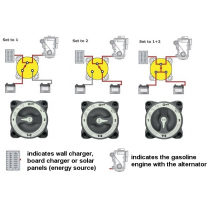Blog - Chargers and charging

Battery charging from a generator on boats
FAQ: Battery charging from a generator (alternator) – on boats
Question: I have a boat with the gasoline engine. The gasoline engine moves the boat and charges the mainboard battery. When I replace the battery with LiFePO4, how should I operate the charging? If the battery gets full the alternator will keep charging to some 14 V. Can the voltage stay like this or should I reduce the voltage (how? to what voltage?) or should I shop the charging (0 V)?
Answer: The LiFepo4 batteries require that you stop charging if the battery is full. If you keep the battery at the full voltage, the battery is in fact internally overcharged and the life span of the battery will be reduced. That is why the best way is to stop charging (turn off the charger).
However, in the case with the alternator (for a gasoline boat), you cannot disconnect the battery from the alternator when running... The alternator (or regulator) would burn without battery… The gasoline engine with alternator needs the battery to be connected all the time.
If this is your case, we suggest making a battery pack with two batteries. One will be the original SLA (lead-acid) battery and the other will be the main (new) LFP battery. When you reach the full charge voltage (e.g. 14.4 V), you simply disconnect the main LFP battery. The alternator will keep charging the SLA battery (there are fewer issues with the overcharge of the SLA battery). And when your main battery becomes depleted (12V or less underload) you connect it back to the alternator and start charging again.
Image: a battery switch that allows connection and disconnection of the secondary battery bank. Source.

 English
English Česká republika
Česká republika Germany
Germany France
France España
España Italia
Italia Sverige
Sverige Polski
Polski Nederland
Nederland









